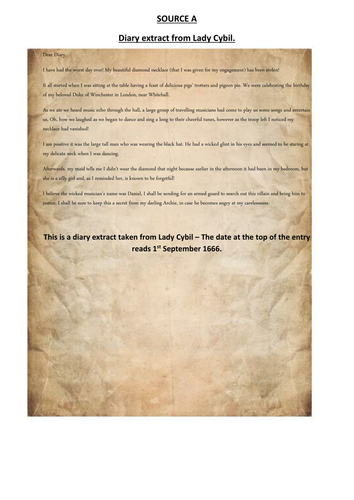
11Uploads
3k+Views
459Downloads
English

Geography Science English - data analysis and application for KS2
Read the Sailor's Diary - A recount entry, highlight key information then use the database of information to cross reference the key geographical observations to match the Sailor's account to which island he is on.
In the example provided he is on the Galapagos, but students could then create their own dairy entries using scientific and geographical facts to support creative writing.
Children record conclusions on a thought map.
Individual and a large paper provided for supported group (shared write)
An advanced application skill suitable for KS2 children.

Science and English - Magic Bean Investigation.
LAUNCH your traditional tales/twisted tales project by creating a beanstalk in your classroom. Then allow the MAGIC letter to appear from a mysterious Fairytale character.
Give each group a RUNNER bean seed to grow but attach the little magic scroll to each one...
The wonder and magic has been created.
Children create a science investigation to determine which liquid allows the seed the grow the best.
After forming a conclusion the children must then use literacy skills to write a letter and set of instructions back to the characters in Far Far Away to tell them how to grow the magic beans.
Also included Wanted poster to stick around your room (just replace the picture with characters from books and films you study).
This was used as a HOOK to apply science, English and wonder into our TWISTED tale project, where the letters down the beanstalk finally revealed it wasn't Red Riding Hood in trouble but the kindly wolf.
Contains: STORY Letter scroll, Poem Scroll for beans, example investigation sheet and modeled writing sheet. Everything you need for a few lessons worth of magical learning!
Objectives: Writing Instructions
Designing an investigation
Recording and concluding a scientific investigation
Reading and interpreting (Story on the scroll)
Creative writing - Letter writing to Fairytale Folk

Reading Investigation Mystery Historical Sources
Using a bank of historical sources the children will solve the mystery of the Diamond in the Fire. The children are slowly provided with Historical sources A-G and slowly retrieve evidence from the text to solve the mystery of who stole the precious necklace and how it ended up in The Thames during the Great Fire of London.
This activity can be advanced as you like, with support and guidance providing the differentiation making it suitable for any KS2 Year Group.
I have used Hot Seating of characters, drama and even researched the Great Fire on iPads to stretch this mystery out over the course of a week.
A superb resource that allows children to use evidence to interpret historical sources, infer beyond the literal and pull direct comprehension from text.
History, English and Guided Reading.
This is like a murder mystery dinner party for your classroom!
Below is a sample from the Teacher's Guide that explains some of the findings from the Historical Sources:
Source A - Lady Cybil had a birthday party. She believes she wore her necklace but her maid tells her she didn’t. She cast suspicion on a mysterious Daniel, however she admits she is a forgetful and absent minded character.
Source B - Shows Lady Cybil did not meet a DANIEL as the musician was called David.
Source C - This shows that the day after Lady Cybil’s diary entry the Great Fire of London occurred. This could mean the city was in chaos so perhaps the robber got away in the confusion of the next few days.
Possible side research on Great Fire.
This also gives important locations to use later with the MAP evidence.
The guide continues like this revealing the story and guiding teachers through this exciting mystery.



